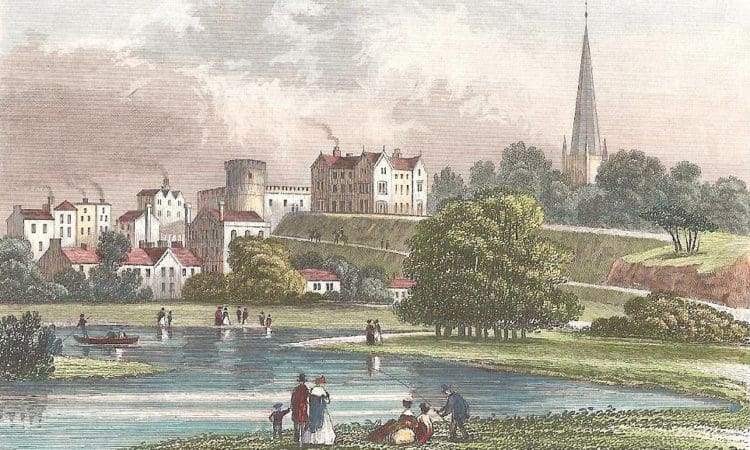Download The Picturesque Wye Tour brochure here
When the Reverend John Egerton began entertaining his guests on the river Wye at Ross, little did he know that he would start a fashion for travel down the Wye Valley that continues to this day. The Wye Tour, a two day boat trip along the Wye from Ross to Chepstow became the height of fashion in the late 18th century. Egerton was the Rector of Ross on Wye between 1745 and 1771. He was the son of the Bishop of Hereford, and married to Lady Anne Sophia de Grey. They entertained many visitors and around 1750 he had a boat made specifically to take their guests on river trips along the Wye. Word soon spread about the ‘wonders of the Wye’ and from this private excursion demand grew for public tour boats. Poets, painters and writers seeking the Picturesque began arriving, helping to stimulate a fledgling tourist industry. Visitors needed places to stay, boats, boatmen and local guides to convey them along the river, as well as provisions for their journey. By the 1770s the trip was firmly established as a two-day outing; from Ross to Monmouth on the first day and Monmouth to Chepstow on the second. There was much to inspire the romantic traveller: the scenery, the industry which lined the riverbank, the ruined abbey and castles and the famed Piercefield walks near Chepstow. Some visitors started the tour at Chepstow, some rode rather than taking a boat. Others, like William Wordsworth walked. Artists especially, like Turner and Sandby, chose to travel on foot as it gave them time to sketch and paint. This was a new type of travel, focusing on the appreciation of scenery. Tourists came to be inspired by the landscape – to paint, sketch, and write.
2020 is the 250th anniversary of William Gilpin taking the ‘Wye Tour’ in 1770, an event which heralded the birth of British tourism. Gilpin was a pioneer in the appreciation of landscape in Britain and his ideas led, much later, to the designation of protected landscapes – including National Parks and Areas of Outstanding Natural Beauty of which the Wye Valley is one.
Gilpin developed a set of rules for defining ‘the Picturesque’, creating an artistic movement which had a lasting effect on landscape appreciation. The popularity of the Wye Tour was greatly assisted by the publication of his best-selling guide book – Observations on the River Wye. It became the bible for visitors to the area and was soon in its fifth edition. Gilpin had delayed publication of his book until a suitable method of reproducing his watercolour illustrations had been found. The development of aquatints, pioneered by Paul Sandby in the 1770s paved the way for Gilpin to use the technique. This mass production of images brought the beauty of the Wye Valley to a much wider audience than ever before.


Observations on the River Wye was the first tour guide to be published in Britain, helping travellers locate and enjoy the most Picturesque scenes in the Wye Valley. They followed a set itinerary and dined at specific locations, took walks to particular viewpoints and visited must see romantic ruins, making the ‘Wye Tour’ one of the first ever ‘package holidays’. The Wye Valley, with its gorgeous river scenery, became the first of Britain’s great landscapes to be ‘discovered’ – and the birthplace of British tourism (an industry now worth £100m a year to the area).
By 1800 the trip had become a must for people of taste and fashion; unable to take the Grand Tour because of war in Europe they holidayed at home. Monmouth writer Charles Heath cashed in on the popularity of the Tour. He set up a printing business in the town in 1791, producing guides and pamphlets about the Wye Valley which ‘have tended to bring into fashionable notice the Tour of the Wye’. Many visitors kept journals and diaries as well and by 1850 well over twenty guidebooks had been published. The heyday of the Wye Tour was from 1760 to the 1830s, but its popularity was renewed in the 1870s when the Wye Valley Railway opened, allowing many more people to enjoy the beauty of the Wye. In the 1880s thousands of people arrived at Tintern Station to walk to the Abbey and view the harvest moon rising through the Rose Window.
Travellers in search of the Picturesque had some essential items in their luggage, which were necessary to control the untamed landscapes they encountered. Gilpin advocated the use of a Claude glass. This was a small black convex mirror, about four inches wide on a black foil, which miniaturised the reflected scenery. Many artists and tourists used the glasses to manipulate their view of the landscape. This meant they had to stand with their back to the view, looking at it in the mirror! As Gilpin wrote, Picturesque practice always involved some ‘improvement’ of the landscape. A Claude glass became an essential item in the tourist’s luggage.
Find out more about the Wye Tour and the Picturesque on the Picturesque Piercefield Walk